How to Buy a Vehicle in Ecuador (Plus Ownership Costs) What I Learned
Buying a car is something we swore we would never do when we moved here a year and a half ago. We were terrified of the style of driving and the apparent lack of road rules. Well, we’ve loosened up a lot since then, and we are ready to be independently mobile once again.
Our Experience Buying a Vehicle in Ecuador
Obviously, a driver’s license is required. There is a bit of a mistaken view here among foreigners about driver’s licenses. An international driver’s license is valid only for one year. After that, you must get an Ecuadorian license.
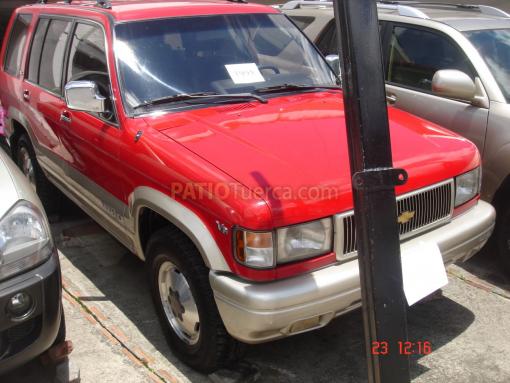
Buying a vehicle is an unusual experience here.
First of all, a vehicle that would be completely worthless back home, is worth a verifiable fortune here. For example, an 11-year-old Dodge Caravan might be worth a few hundred dollars in Canada (if it’s in good shape) and here, it is listed at $8000.
We bought a 16-year-old Isuzu Trooper (sold here with the Chevrolet branding on the body) and paid about 6 times the value it would have had in the United States. But then again, gas is just $1.48/gallon for standard or $2.08 for extra.
But there is something interesting about the vehicles here in Ecuador:
- First of all, there is absolutely no rust. Anywhere. Our 16-year-old beast looks almost perfect. What you would expect out of a 5-year-old car back home. The cars from the coast, especially Guayas province are sort of shunned here in the Sierra. They are available but are much cheaper. There is a view that the vehicles with Guayas plates are of poorer quality – partly because of the salt air on the Coast, and partly because of the idea that people from the coast don’t maintain their vehicles well (local biases). I don’t know, but this is probably also said in reverse. You can always tell where the vehicles are from, by the first letter of the plate. Guayas cars have license plates that start with “G”. Azuay cars (plates starting in “A”) are more expensive. For the best prices, head north to Quito and get a car from the northern Sierra provinces.
- And secondly, it is the culture to take awesome care of the vehicles here. I think partly because of the high prices and partly because Ecuadorians appreciate their things, the cars are immaculate. I’m confident that you’ve never seen such a clean motor anywhere. It’s going to be a challenge to keep our car as clean as our neighbors.
The prices stay high, thanks to high import taxes on new vehicles. And as I understand, only new cars may be imported. So that leaves a limited pool of vehicles to choose from.
There isn’t a central CraigsList or eBay here, but there are a few great classified sites. For used car listings check out:
We ended up buying from a dealer. A friend took me and the truck to his mechanic to check it out, and perform a cylinder compression test. The test and a road test cost $5.
This was a friend of a friend, so it might have been a little low – but gives a point of reference.
The documents need to be notarized (costs $45). Payment is via a certified check, which costs $2.50. And if the vehicle is already registered, you won’t need to pay until it comes due. Ours is good until next fall.
Hopefully, we won’t be posting much about dealing with mechanics, but time will tell.
What’s been your experience in buying a car as an expat?
Cost of Owning a Vehicle in Ecuador
We are frequently asked about the costs to run a vehicle here in Ecuador. Of course, the specifics will depend on the type of vehicle you purchase and where you have it serviced – just like in any other country. To give you an idea, here are our vehicle costs:
Costs to Own and Run a Vehicle in Ecuador: These are actual costs, but it’s important to note that your costs will vary. Repair costs can never be accurately estimated – so we haven’t included them.
If you take your car to a local mechanic instead of the dealer, you’ll not only pay much less for the labor – they also know great ways to save on parts.
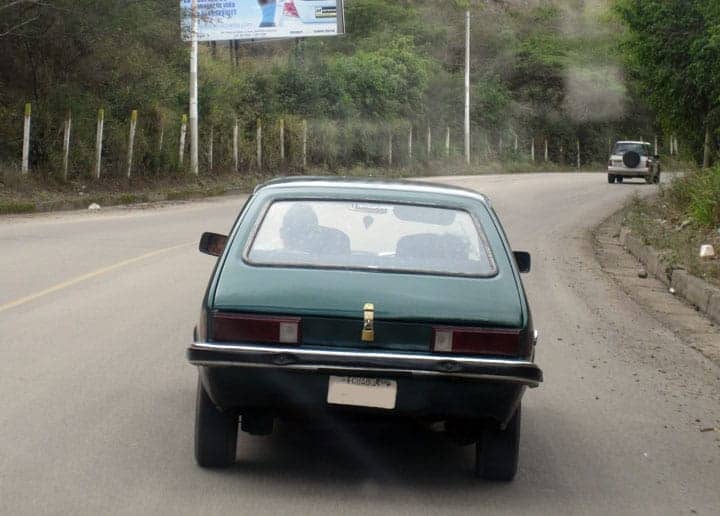
Fuel Costs in Ecuador
Our truck is old, it’s a 1994 Isuzu (Chevrolet) Trooper. The 3.2L V6 engine is anything but good on gas. But because of the cost of fuel in Ecuador, it doesn’t really matter.
At just USD$1.48 per gallon, it’s hard to worry too much about the cost. We spend roughly $80 per month driving approximately 1200 km.
Fuels Costs: $80 per month
SOAT: Ecuador’s Mandatory Car Insurance
There is a mandatory insurance in Ecuador, called SOAT. It is obligatory insurance that covers medical expenses in case of an emergency. It really is an exceptional system, providing free medicare in case of automobile accidents. For our truck, it costs $63.45 per year.
Smaller vehicles are less. As I understand it, those injured in a car accident are taken to the nearest medicare center and the program pays for the costs – regardless of if it is a public hospital or a high end private one.
SOAT Costs: $63.45 per year
Car Matriculation (Registration) in Ecuador
The annual matriculation costs $66.79 for a large vehicle. The government has implemented a new green tax for all vehicles with engine sizes over 1.5L. It increases incrementally, this year costing just $46.92 and increasing to more than $100 in five years.
The green tax depends on the year of the vehicle and the size of the engine. All engines over 1.5L are included in this green tax.
There is a provincial tax (Taso solidario) that costs $12 for the year. I believe that this is per passenger vehicle, regardless of size. This can be paid at the Transit Commission. Cuencaire, is the entity that does vehicle inspections (including emission controls).
There is a fee for the inspection, but no charge to return once the problems are fixed. I had to purchase new fuel injectors to make our truck pass. Passenger vehicles are ranked differently than commercial vehicles.
Matriculation Total: $114.31 ($113.71 plus $0.60 bank fee).
Cost of an Ecuador Oil Change
Oil is not subsidized like gasoline. Our truck takes about 1.5 gallons of oil in an oil change. This costs about $35 plus $3.50 for the filter. Our mechanic charges $3 labor to change the oil.
Here they recommend oil changes every 3000 kilometers, especially with older vehicles. We get an oil change roughly every 2-3 months.
Annual Oil Change Totals: $207.50 ($41.50 x 5 times per year)
Auto Accident Insurance
Although not common for older vehicles, we found and purchased auto insurance for our truck. Despite its age, it is worth about $10,000 here. In the US, I found an equivalent vehicle online for $1800.
Something notable about vehicles in Ecuador is the care that the owners take of them. The truck has been especially well cared for.
We had to look hard to find a company that would insure our truck – but eventually, we did. It includes zero deductible 3rd party insurance, full replacement value (with zero deductible) in case of theft, and full replacement value in case of an accident.
There is a $10.40 addon that gives unlimited (country-wide) roadside assistance. That is an annual cost and has no additional cost. Last year I added it on a whim – not sure if it would even work.
Just a few months after, the seal on the clutch went – leaving us stranded on the side of the road. I called the number, gave them my plate number and they dispatched a grúa (tow truck). The driver didn’t request any papers – and towed us to our mechanic. No cost – I only needed to sign that the service was performed. Did I mention the cost is just $10.40 per year? Insurance is paid annually (not monthly).
Insurance Annual Costs: $575.40 ($565 plus $10.40 roadside assistance)
Parking Costs in Ecuador
There are numerous pay parking lots in the center. Costs range from $0.60 to $1.00 per hour. There are parking attendants to help you park safely and to watch your car. We use these lots every week and have never had any trouble. We spend on average about $10 per month. In Cuenca, the shopping centers still offer free parking – while in Quito you have to pay.
Outside of the City Center, there are tons of places to park for free. Just be sure that the signs allow it. If you ignore the signs, you can expect a $10 fine.
By the way, if you don’t pay the fine, you won’t be able to matriculate your car – which means you won’t be able to leave the city. Car papers are seldom (if ever) checked for matriculation inside the city – but once you get on an inter-provincial highway police checks are frequent.
A friend of ours drives a very old, very well-used Fiat and he just hasn’t gotten around to matriculating it for the past few years. So he drives within Cuenca frequently – but takes the bus when he wants to visit a town outside of city limits.
Parking costs: $10 per month
Annual Costs of Running a Vehicle in Ecuador
- Fuel: $960 ($80/month x 12 months) (driving approx 1200 km)
- SOAT: $63.45
- Matriculation: $114.31
- Oil Changes: $207.50
- Auto Insurance: $575.40
- Parking costs: $120 (approx $10 per month)
Annual Vehicle Expenses: $2040.66 ($170.06/mo)
Don’t forget: these cost don’t include repairs or maintenance. We haven’t had to do much to our truck. A new Bosch battery cost $115. Fuel injectors cost $120 each plus installation. The clutch seal (including labor) cost $30.
What do you think? Reasonable? High or low?
What’s the Price of Gas in Ecuador?
A reader recently asked on Twitter: What does fuel cost in Ecuador?
A lot is said about cost of living in Ecuador. It is true that the cost of rent and food is less – but that can be harder to quantify. Gas is gas. What does it cost to fill your tank?
Recently the Federal Government removed the subsidy on jet fuel. This has increased national flight costs significantly – although they still aren’t very expensive.
As an oil-producing nation, Ecuador offers huge benefits to its citizens by subsidizing gasoline and propane. Propane is almost free.
What Does Gas Cost in Ecuador?
Fuel is sold by the gallon and there are three options.
- Extra: $1.48
- Super: $2.19
- Diesel: $1.037
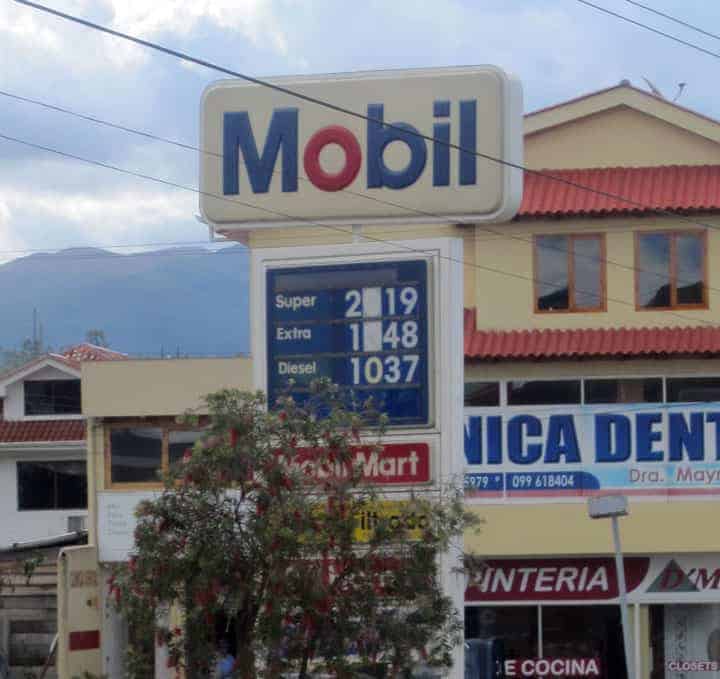
So we can fill our old truck for $20 and drive around 300 kilometers. We spend around $80 per month on fuel. In contrast, we used to spend around $250 per month in Canada, driving our new Honda Civic sedan. Of course, we used to drive more in Canada, but the contrast is still huge.
As I write this, I remember that my first car (’88 Honda Civic) could hardly hold $20 worth of gas. Of course, that was more than 15 years ago. Today, I can fill our V6 full-size truck for $20. It only goes about half the distance, but the price is hard to beat.
It’s funny, but after almost three years we have become very accustomed to life here. We don’t compare fuel costs to Canada anymore. We compare fuel costs here. For example, we almost never purchase Super, although it is still just a fraction of the price of the cheap gas in Canada.
Because of the low cost of fuel, the government has a hard time controlling gas stations on the border with Peru and Colombia from selling fuel in bulk to people crossing in from those countries.
Recently, the President announced that he was taking control of these stations as they weren’t complying with Federal rules.
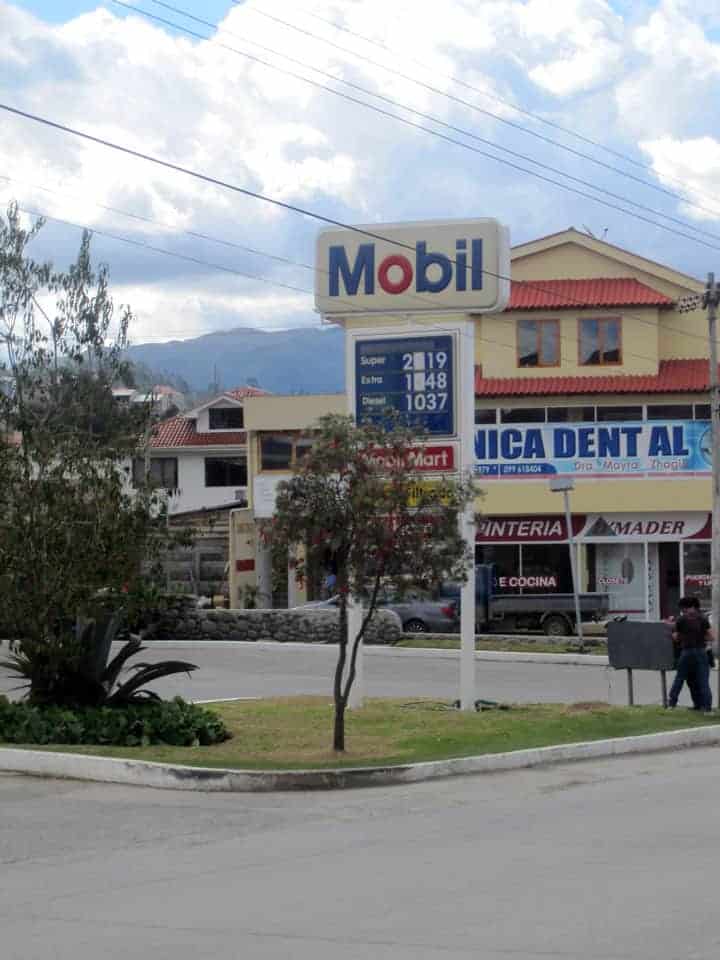
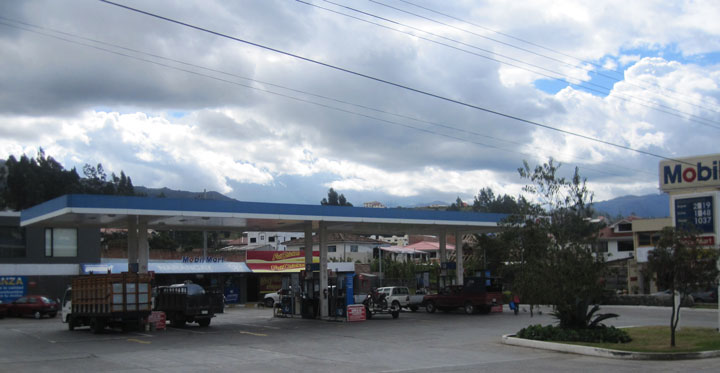
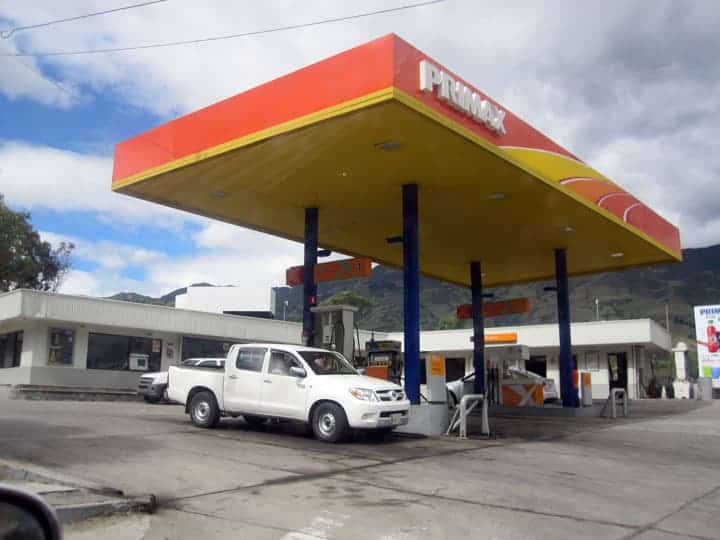
The Cheapest Fuel We’ve Ever Seen
While Ecuador has very inexpensive gasoline, it isn’t the cheapest that we’ve seen.
When we were in Venezuela a few years ago, we filled our rental car for USD$0.90 – after driving it for 4 days all over Margarita Island. The price is approx USD$0.09 / gallon (yes that nine cents per gallon).
What’s the cheapest gas you’ve seen?



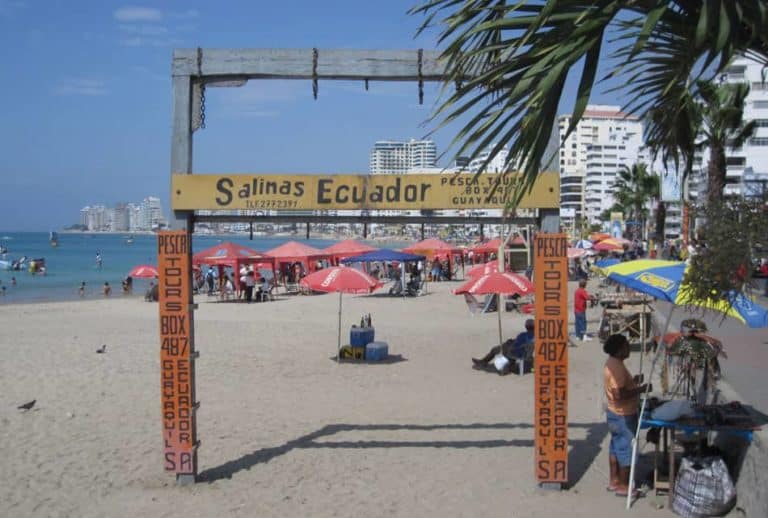
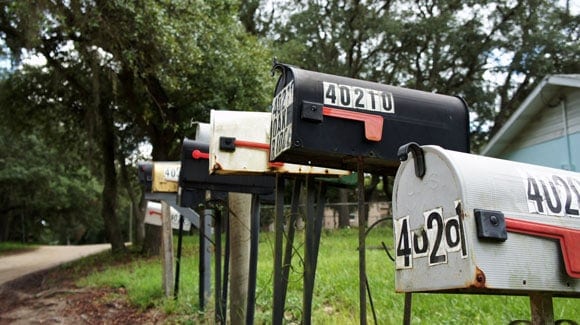


Hello 👋 I’m from japan I’m interested in your product and I would like to know more details.. I look forward to hear from you… thanks
Largely accurate though some “facts” are from a Cuenca (high in the Andes) perspective. For example, the incidence of “no rust” is an altitude phenomena. Not enough oxygen for anything but a bit of surface rust.
Hey buddy, I am going through the same process. Would you be able to share the name of the insurance company you used? Thanks so much.
Jack
We used Corresur Asesores de Seguros in Cuenca.
Hi! My family and I are moving to Ecuador in May. We are hoping to find a place we like, buy a house and start the Visa process. Hopefully we can do all this within 6 months. I need to buy a vehicle when we arrive. Will I be able to do this with my US drivers license? I will not be getting an Ecuadorian DL for some time due to the visa process. Renting a car for 6 months is a little outside my budget. 🙂
Hello. Thank you for your blog on Ecuador. My husband and I are moving to Quito next month. We are both over 70. Would we be able to finance the purchase of an automobile? Thank you for your input.
Thanks a lot for all this info. I’m planning on buying a car for a young man who lived with me as a child. He lives in Guayaquil so I’m hoping the cost will be affordable! I’m sure he’s fairly knowledgeable about cars, but I really appreciated your info for my own education.
Hello, I was wondering if you could give the information or the name of the third-party car insurance company you were using. I have an older car too and I’ve heard no one will insure an older car here in Ecuador.
We used Corresur Asesores de Seguros in Cuenca. There were limited options for older vehicles at the time. I looked it up and the annual insurance cost was $575.40 ($565 plus $10.40 roadside assistance). This was 6 years ago – and the price didn’t increase year over year.
Good day. I own a house in Puerto Lopez, Ecuador. Just been here 3 months.
There are a lot of Tuck Tucks for Sale used, and I wonder if there is a special license plate available so that I can run one privately?
Thank you.
What can you all tell me about the IVA Tax on used or new vehicle purchases?
Do you pay the current 14% IVA on the total sale price of either a used or new car ? And when?
Thanks~
In my endeavor to find out all I can about living in Ecuador, I thought about my truck and moving it with me. However, I just got a notice from a company here in the states that advises that Ecuador will not allow used vehicles to be brought into their country. If you saw the truck, you would understand – 2001 Ford Lariat, showroom condition with 90,000 miles…… I am not sure who to call or talk to when the time comes to see if there is any way to bring this vehicle with me. Can you advise me or point me in the right direction. Thanks in advance……
It just isn’t allowed – regardless of the the condition of the vehicle. You can buy a car here – or bring a brand-new one with you (as part of your permanent residency).
Thank You Bryan……. I will just wait and sell mine here …… and buy one there…..
I so appreciate you and your wife (I have watched several of her videos today) and your sharing with us “very green” gringos…………
Not possible. Unless, you are Ecuadorian AND the car is less than 5 years old and under $20,000. And they will check to make sure EVERYTHING. You also can only have 1 driver for that vehicle and that is for 5 years and it can not be sold during that time period either.
Or if you are a diplomat. Not likely.
If you import a new car it has to be less than 1 year old and the purchase price is the tax you pay, plus the shipping. So a $30,000 car will cost 30Gs of tax to bring in. Or you can buy new here and pay 50% tax making the total $45,000 total. But the old classic can’t stay here. Even if you drive it down, do a shipping container past the Darien Gap and drive through Colombia. Sorry.
HOLA HOLA ..
Hay how you ? Hope you are good 🙂
We are good , we are a couple from Australia. We are traveling around Ecuador in our campa van … We are heading to quito in 1days. Need some
Where to camP or park our car ? We sleep in our Camper van
Also we are trying to sell our van , it’s adertised on
http://www.drivetheamericas.com/forums/ford-econoline-van-sale-2500
Can you help us sell our car , or know people that can help us ? Before we go back to Australia soooon, Please
Peace
I am trying to find the name of the big Chevy dealer in Guayaquil. Thanks, Nick
Bryan, any idea what visa class or proof of residence is required to register a vehicle in Ecuador?
It’s been a few years, but when we bought our first car, we were on a temporary visa. I used my passport as identification. I understand that even as a tourist you can buy and register a car.
Hi there Bryan, you mentioned that driving license are required (obviously) but will my UK license be any good there?
Thanks in advance, Harry
I expect so, but I’m not sure. Once you get residency you’ll need to get an Ecuadorian license – which can be based on your valid foreign license. As a tourist, most foreign licenses are acceptable – but you should confirm with the Ecuador transit authority (ANT) that your country is approved.
Well the 3.0 Liter limit makes my earlier question about my RAM moot. Still, those Chevys= the Vitara and Aveo- assembled in Ecuador were very competitive.
Dear Brian,
I am a new subscriber and i am ready to retire to Ecuador. I qualify for their Pensionado program, I receive Social Security, but I am only 55. I a a little confused. i have a 2012 RAM 4 x 4 that is worth $20,000. Who determines the price? I was going to just sell it here, and if it is 8k to ship, i will. What would be the tax imposed if over 20 for a pensionado?. Is 8k to ship a vehicle correct? I would of course ship it to a port, Manta probably. I have read that Ecuador assembles an Isuzu Vitara- now a Chevy- I saw 2012 models, 3000 miles. 4 x 4, air, manual for 15k. Also an Aveo Chevy was the same price, but I like the SUV 4×4. The other imports were about double in price.
Vendo VW POLO 2005, un solo dueño, cero choques, 130000km, placas GOL565, 8500 dolares, movil 0998445435, Cuenca Ecuador. Solo hasta el viernes 13 sep 2013.
Hey Bryan! Helpful Article and the sites you provided for shopping for a vehicle are helpful. Thanks! Una pregunta, Que necesito preguntar to know I am getting a legit vehicle with the title(correct doc), etc?
I’m seeing some good deals, but not sure if these vehicles are legit or?? Any tips or advice greatly appreciated. I would hire a mechanic to inspect, but wondering about the title/proper paperwork coming with the vehicle. Thanks!
You can check the with ANT (National Transit Agency). You can check fines on the car based on license plates. I expect you can also check with the national police to ensure that it wasn’t stolen, but I don’t know about that.
In addition to it being stolen, you could also be responsible for SOAT (mandatory insurance), matricula (registration fees) and certain taxes (that vary across the country). When we bought our truck, it came with over $300 in fines.
I am not able to get the links above to open. Is there any other place one can go to find pending fines or “tickets” on a vehicle. I understand that if you buy a vehicle you become accountable for all the the accrued fines.
The links work – maybe you have some type of block on your browser? Or are you looking for something in English?
Hi Bryan,
in one of your posts you’ve mentioned about Auto insurance, could you please advice the name of the company?
Thank you.
We have our truck insured with Corresur in Cuenca. They are located at Gran Columbia 20-99, Edif. Covac. corresur@yahoo.com
I was wondering if anyone can give current info on an expat with residency financing a car or truck in Ecuador. Insurance cost information would be help too.
Thank you for this article! I just sent the link to my husband, as we have been here in Quito 7 months are are wondering about how to purchase a vehicle. I noticed several other related topics that are all things we’ve asked, so I am excited for all this info!
Thanks Kale – so glad that you’re enjoying the site. The vehicle purchase is more complicated than it was in Canada – in part due to the language but also due to the mountains of red tape and photocopies.
Would you be interested to share your expat story? Would love to share it.
All the best!
Bryan
We are a retired couple with 3 border collies. After reading all of this about cars in Ecuador we are wondering — just what is the import tax/duty on having our own vehicle shipped from Oklahoma to Cuenta? We have a ’96 Dodge Gran Caravan – complete with dog crates for taking our “girls” everywhere with us! (and totally paid for) Also, is it better/cheaper to ship our furniture/etc. down there or just buy when we get there? (we would be renting at first). We are trying to find out as much as possible about taking on this retirement project before we even consider coming down for a visit to see in person whether we would like it. Thanks for any help you can give us! Oh, and is it a problem to bring all 3 of our girls?? (afraid that would be the deal breaker for sure!)
Hi Mary, I don’t think you’ll have success importing your van. From how I understand it, you can only import new vehicles. You’ll probably be better off buying a used vehicle here. In general, the used vehicles are in much better shape than we ever saw in Canada. Its actually quite impressive.
In regards to your pets, you might want to check out: Can I Bring my Pets to Ecuador? and What Can I Bring to Ecuador?
My son and I were browsing the Quito Craigslist ads for vehicles. We saw several ads for cars that were here in the US. What’s up with that???
Good question. Guess you’ll have to ask the vendor.
I’ve heard that the gov’t will be implementing and/or raising tariffs even more on luxury items like new cars, shoes, etc by the end of the year. Has anyone heard this and know details?
Wow! Not sure if this is an appropriate post/response… are people not allowed to bring their personal vehicles from the US or Canada? In other words, you cannot drive to Ecuador, simply keeping what you already own from the old country?
Hi Mark – thats right. No used vehicles come into Ecuador. This keeps used prices high – but also keeps the used vehicles in surprisingly good shape.
You can actually bring a car no more than 4 years old including the year of import. The value has to be no more than $20,000 and no bigger than 3L.
The above comment is not quite accurate. I drove my older vehicle to Ecuador and was able to ‘temporarily import’ for 3 months. It was an easy process at the border from Colombia. If you overstay the 3 month visit you will likely lose the car!
Brian, I am returning to Ecuador this winter this time without my car. Am I able to buy a vehicle in Ecuador while I am in Ecuador on a visitors visa?
You say you don´t need to register until the fall. Will you be doing a follow up on the traspaso and matricula?
I am sure alot of people would be interested on how that works.
Here is the story of my buying and financing a new car in Ecuador. These were posts on the Yahoo Group ecuador_expats forum.
_____________________________________________________
04-18-10 (first post)
I have decided to buy and finance a 2011 Hyundai Tucson, “full equipo”, manual transmission, 4X4, with air conditioning, luggage rack, rear cargo cover, $29,990. If you want, add $7,000 for an automatic, but you also get a rear-view TV, but that’s it. There are other Hyundai Tucson options available. The “standard” is manual transmission, 4×2, and none of the other above features. It’s $24,990. The “semi-full” at $26,590 is manual transmission, 4×2, and adds A/C and the rear cargo cover.
By the way, I also looked at the 2010 Nissan X-Trail 4X4 (the 2011s are not yet available); it was $31,500 marked down to $29,900, and also the 2010 Chevrolet/Suzuki Gran Vitara (4X2, 6 cyl), $25,000 to $29,000. Both were comparable (price range and features) according to the car websites. Fortunately I had driven the Gran Vitara as a rental for 3 days when I got here. It’s gutless even if it is a 6 cyl. The Hyundai 4 cyl (4×2 or 4X4) has more horsepower and drives much nicer. Another thing about the 2011 Tucson is that is a completely revamped body style that will be around for a few years and hopefully won’t depreciate as much.
All of the taxi drivers I polled voted for the Hyundai over the other two makes. Many of the Hyundai taxis have well over 400,000 KM on them.
Another by the way, I did look at a lot of used cars. I walked Avenida España here in Cuenca from one end of the used car trail to the other. I didn’t want to overlook that possibility; it seemed prudent since my capital and monthly income is modest. But every Ecuadorian I talked to advised me to buy a new car if you can possibly do it. Since we are blessed and don’t have a rent or house payment, I decided to take on a 70% car loan and go for it. Now get ready for the terms.
Produbanco, my long term bank, offered 15.19% for 4 years. You also must buy their insurance for the 4 years and they will finance that too; that added a whopping $5,200 to the tab (yikes!!). You can obviously pay the $5,200 in cash if you’d like too, but they will finance it if you choose to, which I did. The interest rate is variable (adjusted each 6 months, and recently had been up to 17%), but because the insurance is applied up front for the four years, the amortization is a fixed payment unless it gets adjusted of course. I say this because it is very different from the other bank that I got approved for.
I also looked into Banco de Guayaquil. They are the only bank that I know of that provides a 5-year loan and that’s why I checked them out. Their rate is 15.2% and also variable. Again insurance is mandatory, also it must be provided by them. However they just require the first year of insurance to be dealt with up front. You can pay it in cash, or finance it. After the first year they tack on another year of mandatory insurance, and again you can pay it in cash or add it to the principal balance. That potential revolving principal balance and the fact that they don’t use a 360-day bank year for calculating interest means a different payment each month. The first year it just varies by a little bit depending on how many days of interest there are in the month, but if you finance the second year of insurance, then the monthly payment in month 13 jumps up dramatically. The car dealers tell you nothing about this. They just quote the initial payment, so buyer (of financing) beware. I asked for an amortization schedule from the bank person, and that’s how I discovered the procedure. I could not get the same payment myself running the numbers on Excel. By the way, the projected costs for the five years of insurance with Banco de Guayaquil is $6,990 (another yikes!!); the first four years by the way is $5,915 vs. Produbanco’s $5,200 for comparable coverage).
Furthermore, both banks require a GPS tracking device installed (this is labeled as “dipositivo” in the proforma, and costs another $600, and there are approximately $250 of “gastos legales” (legal fees) that the borrower has to pay as well, both of which of course you can finance if you want to.
I decided on Produbanco primarily to get over the pain faster (4 years instead of 5) and not having a whacky payment schedule.
But there is a problem. The Hyundai vehicle that I ordered didn’t arrive from South Korea yet. It has been over a month since I ordered it. There were supposed to be 1,000 Hyundai 2011 vehicles arriving in March in Manta (for 40 Hyundai dealerships in Ecuador ), but only 280 actually arrived. The dealerships kept selling though; talk about unhappy clients who had given reservation deposits with a 10-day delivery promised. Bienvenidos a Ecuador. This situation is supposed to get resolved with more vehicles arriving eventually. I am a squeaky-wheel at the dealership, or “concesionario” as they call it here.
_____________________________________________________
04-24-10
The General Manager at the Hyundai dealer told me on Wednesday that I would have my car by the third week of May; I was in his office when he called someone in Quito and made the inquiry. He then called in his secretary and my salesman and ordered them to track it, so they became witnesses.
I also found out on Wednesday that they actually raised the prices on the standard and semi-full Tucsons by $1,000. That raises the standard from $24,990 to $25,990, and the semi-full from $26,590 to $27,590. Those are starting to arrive and are going like hot cakes. The full-equipo that I bought at $29,990 stays the same. Fortunately my price is locked in if they do decide to raise the price on it. When I first went to “negotiate” the price back in March they told be that there is no discount and that would most likely raise the prices. They weren’t lying. They did lie about the 10-day delivery time though.
_____________________________________________________
06-01-10
Got some relatively good news today. The “factura” (invoice) was sent to the bank today. That’s good because now it is certain that the specific vehicle I ordered has been identified; the VIN goes on the invoice. The vehicle I am told is at the port in Manta where it arrived from Korea. They won’t make a commitment when it will arrive in Cuenca, within a week or so.
_____________________________________________________
06-12-10
I just got a call from the dealership on Friday that the price of the car was going up $3,000. Since my “factura” (invoice) was already issued, my price remains the same. Well I would hope so. Apparently my order three months ago, and a deposit, wouldn’t have kept the price at where it was when I ordered it. They would have just given me my deposit back if I wasn’t willing to pay the additional $3,000. This is the first time I have ever had a car go up in value. A good investment for the car that I haven’t received yet.
_____________________________________________________
06-14-10
Finally (after 3 months)!! It is at the dealership. It got here over the weekend. I sat in it today. Hurrah! Tomorrow, they will install the alarm and the GPS device used to track the vehicle if its stolen, and I should be driving it by mid-day.
I finally financed it with Producbanco who I had originally planned to go with. They finally came around and matched the 5yr financing that Banco de Guayaquil had offered. Both banks later offered 75% financing, vs. 70% as originally advertised. So I went with 5yr to get the payment down (trying to manage my monthly budget), and 75% in order to use the saved down payment to pay for the “matricula” (registration) and other fees that are collected. Those along with the alarm added up to about $1,000. The $600 GPS device was included in the financing. In the end Produbanco’s APR turned out better than Banco de Guayaquil, and it got even better with the perk that no interest is paid in month 12 of each year as long as the first 11 payments are made on time during each year.
Sounds like you had a real (lengthy) adventure. Thanks for sharing!
Have you thought about adding the car markets in Ambato and Quito, (Ambato on Mondays and a little on Tuesdays and Quito on Saturdays,) Thats if you live anywhere near that is. Payments are for the vehicle depend on the seller but cash or bank transfer are the most popular.
Mechanics here are very cheap, We take it to the local specialist, If the brakes need checking to the brake expert, the electrics to the electrics expert and so on, if you need replacements, go to the shop buy it, return to the mechanics and he will replace it, the downside is that it take most of the day, sure you can leave it at the mechanics and they will do it all for you, but this will cost more. Also it´s better to stay and watch as you can keep an eye on them.
Hi Bryan! We've been debating about and trying (unsuccessdully) to figure out which would be the most practical and cheapest way of obtaining a vehicle in Ecuador. Buy in Canada and ship a new car, or buy in Ecuador. We haven't yet found out how much it would cost to ship a "new" vehicle, but when you take the shipping cost into account, would it not balance out in the end if you did have to buy a newish vehicle down there?? What if any, is the tax on vehicles down there?
Thanks,
Deb in Ontario Canada
I've heard (in the form of a rumor) that a person can ship a vehicle if they are on a retirement vehicle. Before we moved, I checked into hiring a container from Halifax to ship to Guayaquil. It was $8000. A car and some furniture would fit. However, I do know that there are many issues involved with importing – just because you are technically "allowed" doesn't mean it will be easy.
I think you would be best off buying a car here. There is no paperwork headaches, and it won't get damaged in transit. I'm not sure about taxes on used cars. We negotiated a price for our car and thats what we paid. Not sure if taxes were included or exempt. Most of the products here show pricing including tax. I do know that import taxes are high on vehicles coming in.
Hope this helps.
Thanks Bryan, but not sure what you mean by "a person can ship a vehicle if they are on a retirement vehicle." or is this a typo, like my "successDully instead of successFully"!! Shipping is such a complicated issue unless you start out on a coastal sity and plan to end up on a coastal city. Shipping the "stuff" to the freighter and then from the freighter to the final location in Ecuador (especially if it is in central, very out of the way rural Ecuador!) Complicated and very expensive I imagine. Have you ever heard of anyone driving to Ecuador from Canada or the US? It has crossed our mind to hire someone to drive a transport truck down…….if possible and if financially reasonable vs shipping by freighter, but I can't imagine the problems involved at each and every border from Mexico onward!! I would imagine it to be an exercise in frustration and fear for sure!! It would be a definite nervous breakdown for me for sure! Do they have psychiatric hospitals in Ecuador?? 😉
Right-o! What I meant was "if they are on a retirement VISA". Got to love the typos – guess I should start proof reading the comments. . .
I agree with your comments about the shipping. I really don't feel its worth the hassle – things really aren't that much more expensive here.
(Thanks for the coffee by the way! It was very kind of you. Thats enough to give us the caffeine shakes for weeks!)
hi i drove from canada 4 times to panama [you need to have a 24 page passport crossing borders usa to mexico[4 stamp,s+fee,s]mexico to guatemala[4 stamp,s +fee,s]–so on the same guatemala to el salvador- san Salvador to Honduras–Honduras to Nicaragua –Nicaragua to costa Rica–costa Rica to Panama. in all 6 Centro American borders with fee,s and stamp,s /25 stamp,s mostly large because of your car.-and every country wants it,s own page in your passport then comes the real problem to get from panama to Colombia no roads, only by boat you have to get transport in Colon panama to cartagena colombia and i did only find one[1] agent that has the autoridad to manage the transport with no given cost for the hole deal[to get this going will cost you 1 week each on time and much maniana[to morrow]rumors of final cost for this is $1200 to $1600 us dollar.if you manage so far-Colombia ,s entry with a car is like a war for paperwork will take with a local guide 2 day,s and many gratification’s+fee,s.the better tip is to take the car to houston port and have it send to cartagena or baranquilla colombia- driving in all of south amarica is very different !!!! i went insted by bus+boat 8000 km bus 5000 km by boat amazon madeiro napo rivers manfred meissner email:blewbyyou3@yahoo.com today 2021-03-09